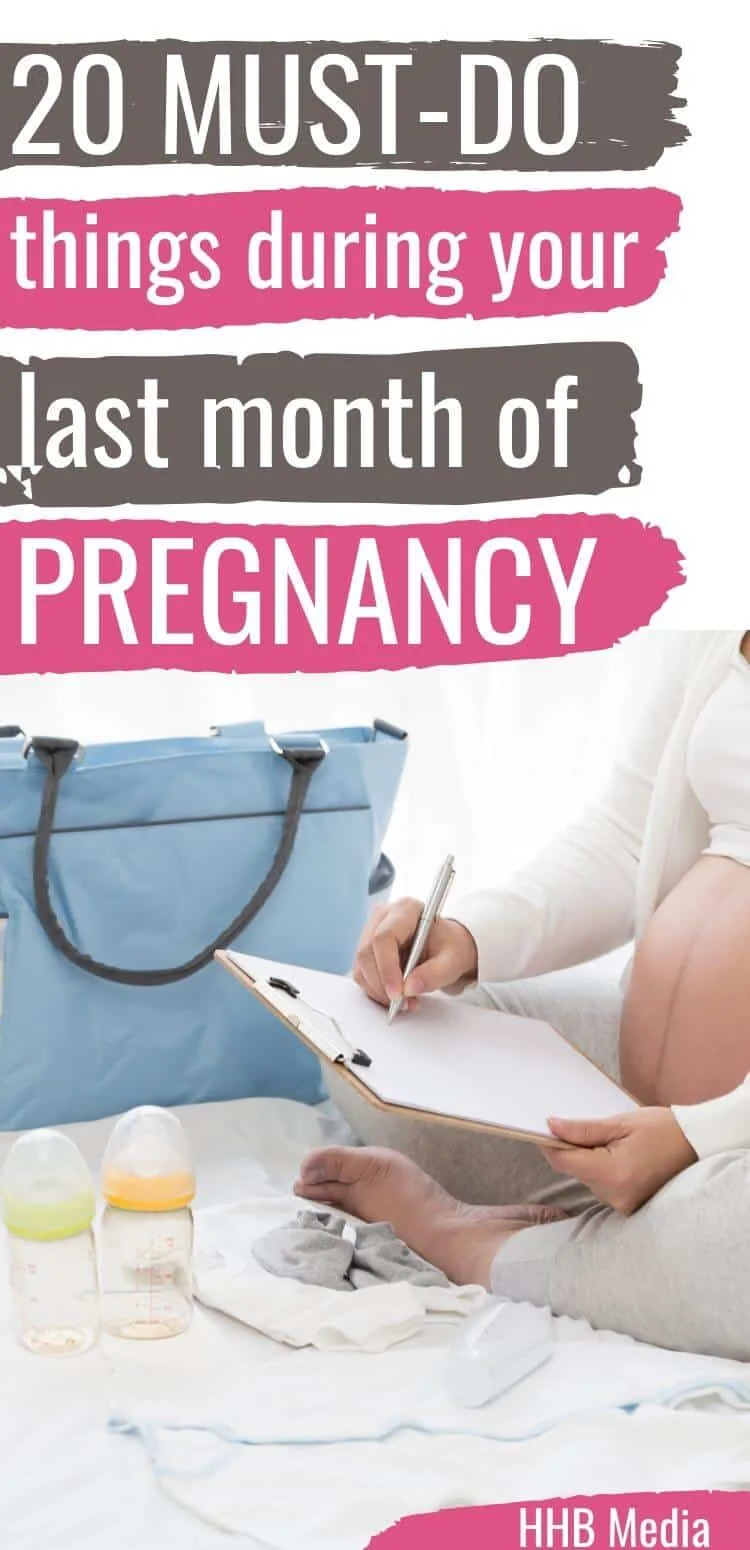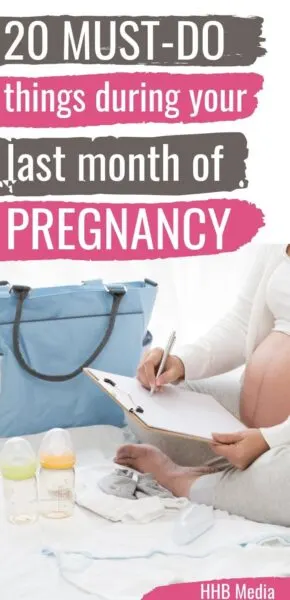Updated October 26, 2023
Are you wondering what you should be doing in your last month of pregnancy?
You are not alone!
If you make sure these 20 items are taken care of your labor, delivery, and postpartum will be much easier.

You’ll feel so more in control and prepared.
Since many expectant mothers deliver during the last month, it is actually best to start preparing two months before your due date or even at the onset of your third trimester.
Like so many things in life, being prepared helps decrease the anxiety and emotional overwhelm associated with childbirth and your postpartum recovery.
Preparing your home decreases the physical demands you will face when you get home from the hospital.
“Taking life as it comes” simply does not work the way it used to. Yes, technology has made many tasks easier; however, it has also added to the list of expectations new moms are faced with soon after delivery.

New moms can experience emotional issues as a result of hormonal changes or a past history of depression.
The main goal of this article is to decrease the stress that new moms experience after delivery.
It is well known that not being prepared for the postpartum period contributes to a more stressful childbirth experience.
We hope our suggestions will be helpful and might bring to mind other ways you can make the postpartum transition as smooth as possible.
20 Things You’ll Regret Not Doing in The Last Month Of Pregnancy:
1. Make freezer meals.
Sounds simple but what a difference a little foresight can make.
When you return home from your delivery, having meals prepared can make the transition a little more manageable.
The anticipatory anxiety of preparing your home for your new baby is the energy you can tap into and this is one of many ways to do that.
2. Pack your hospital bag
Like expectant moms, we all plan to pack a hospital bag.
Unfortunately, it doesn’t always happen because of the countless other things that are on our minds or we go into labor early!
I suggest you pack two bags, one for labor and delivery and one for postpartum.
If you have a partner that will be with you make sure they back a small bag for labor and delivery too.
Take the time and don’t let labor sneak up on you.
It can happen even if you are a first-time mom, we talk all about it in our post on precipitous labor, which is labor and delivery of the baby in less than 3 hours from the first contraction.
We share the story of my precipitous labor from closed up tight to 8 cm in less than 2 hours and my cousin’s recent precipitous labor with twins that was one bad pain, trip to the bathroom and feeling the baby’s head crowning and delivering baby A on the floor of her bathroom, while her husband called 911.
Packing a hospital bag when you are in labor is sure to be missing a few things or having a few things you don’t need!
If you are unsure what to pack the Posh Mama Prepacked Hospital Labor Bag has everything you’ll need
I was on bed rest so it was hard for me to get out and get all the things I needed.
So I really love and recommend this hospital bag bundle from Kindred Bravely.
It comes with the essentials you’ll need for your hospital stay.
Take advantage of Kindred Bravely’s Free shipping on orders over $75 + free returns!

Labor & Delivery Essentials Bundle – $135
from: Kindred Bravely
If you prefer to put your hospital bag together yourself, here are some essential items you’ll want to include:
Nursing bras make breastfeeding easier and they are made to provide support. You’ll be very glad you have them after your baby is born.
If you are formula feeding, I recommend some supportive sports bras.
You will be uncomfortable until your milk dries up and a good sports bra can make all the difference.
Kindred Bravely has the best selection of nursing bras that new moms rave about!
I heard about this store in a new mom’s Facebook group. I was not disappointed.
The quality of their nursing bras is unmatched.
They sell all kinds of pregnancy and postpartum clothing and essentials. If nothing else get a couple of good nursing bras.
You will be so grateful you did. I wish I had the first time around.
Nursing bras are more than just easy to access, they need to be supportive and comfortable. Because you are going to be sore and breastfeeding isn’t always easy.
The very last I wanted anywhere near my breasts was an uncomfortable bra.
Here is a tip: You can get 10% off your first purchase by signing up for their email list.
Take 10% off your first purchase when you sign up for their mailing list!
My choice for the best nursing bra is the French Terry Racerback Nursing & Sleep Bra.
This is the most comfortable sleep and nursing bra. It provides one-hand access for breastfeeding and comes in a variety of colors.

French Terry Racerback Nursing & Sleep Bra | Beige
A labor and delivery gown is a popular option and many new moms have said it was on their “essential list”.
Labor and Delivery Gowns – Kindred Bravely
The hospital is going to provide lovely mesh panties and big thick pads to put in them.
They work well enough, but they are uncomfortable.
When you are transitioning from mesh panties to postpartum panties these high-waisted recovery panties from Kindred Bravely are the ones moms love most.
They are on Best of Lucie’s list and won the Mother’s Choice Award Gold.
Ultra stretchy fabric that holds thick pads with plenty of room to spare.

High-Waisted Postpartum Recovery Panties (5 Pack) | Assorted Solids
I was not prepared at all when I went into labor at 37 weeks. Shame on me.
The hospital has a lot of the little things you’ll need if you forget them.
I had nothing with me because I went to the hospital from my OB/GYN’s office.
I was at work when my water broke. Fun times.
Don’t forget non-skid socks! Your feet will get cold without socks.
Non-skid socks are a must on slippery hospital floors.
You may want to bring your baby name book or a list of baby names you are considering with you.
Even if you are sure of the name.
We were sure to until he was born.
It ended up taking us a few days to settle on a name after he was born.
We went with an earthy baby boy’s name that had not even been on our list!
It happens. Be prepared with a list of names.
Don’t miss:
- Maternity Hospital Tour: 20 Important Questions You Should Ask
- What are Braxton Hicks Contractions?
- 10 Questions To Ask Your Doctor During Your Last Month Of Pregnancy
3. Map the quickest route to the hospital and do a dry run.
This is a must if you want to do what you can to make the labor and delivery experience as uneventful as possible.
Never assume anything when it comes to travel and in this case your destination.
When you are taking a dry run to the hospital, which you likely will do for childbirth classes, consider trying some alternate routes.
Traffic, road construction, severe weather, or an accident might require an alternative route.
Granted we do this often and don’t think twice about it; however, when you must avoid any unforeseen delays, planning your trip to the hospital makes a lot of sense.
An ambulance can get through just about anything, but when driving yourself, you don’t want to have to spend time explaining yourself as a result of a traffic stop.
If you have more than a 15-minute drive to the hospital or birth center, this is really important to stay on top of.
The speed of labor and delivery can easily catch you off guard. whether it is your first baby or your 10th baby, no two labor and deliveries are ever exactly the same.
Some women (like me) have what is called precipitous labor.
Precipitous labor is extremely fast labor and delivery.
It is defined as the delivery of the baby within roughly 3 hours from the onset of regular contractions. (Source)
4. Go over your birth plan (if you made one) to be sure it is still in line with your wishes.
Reviewing your birth plan is a must, especially if you made it out during the early stages of your pregnancy.
There are events that may have occurred during your pregnancy that might require some changes in your birth plan.
This could be medical conditions, discussions you have had with your provider, or in the most extreme situation, you may be having a medically necessary cesarean section.
Even if you don’t make out a formal birth plan, it is always a good idea to at least discuss with your birth partner what your expectations are, and if the plan goes out the window, how you can stay flexible, cope, and have a positive birth experience.
5. Set up childcare and pet care for when you go into labor.
Set up who will be caring for your other children and your pets while you are having your baby.
Make sure it is someone that your pet or children are familiar with and feel comfortable with.
Your labor may come on suddenly and may not go as you plan.
That can lead to a lot of nervous energy that is upsetting to your other children and pets.
Having someone there with whom they feel comfortable can make them feel more secure.
6. Get the baby nursery completed.
Put the bassinet together if you plan to use one.
Preparing the nursery ahead of time is a task that can be fairly straightforward or seem like daunting task.
If you have just moved into a new house or a home with a nursery already built into the layout, the job is more than half done.
Yes, there will still be work to do; however, the work will center around decorating and not structural changes.
For many, your home may need some structural work when designing a nursery.
You will first need to decide which room is best suited to be the nursery (typically a room close to the master bedroom) and how the room can be modified to meet your needs.
Typically the nursery will be the room closest to the master bedroom. Getting used to your newborn not being near you during the night will take time.
When that time comes almost every parent wants their child in close proximity to their bedroom.
With the decision of what room will be the nursery comes decisions about how many structural (if any) changes need to be made.
As long as the room is the right size and access is not a problem there may be little to do other than finishing surfaces and adding your personal touch.
The bottom line is to remember that it is easier to have the nursery completed when you deliver so there will not be added stress.
Deciding to have your baby sleep in your room in a bassinet is very common.
There is nothing wrong with you as a parent if you want to do this.
I can remember watching my newborn sleep for hours, it’s instinctual so don’t fight it.
You’ll probably want to get a baby monitor so you can see and hear your newborn from another room.
The one below is very popular on Amazon. It is our pick for the best baby monitor for 2019.
Infant Optics DXR-8 Video Baby Monitor with Interchangeable Optical Lens
In time you will become comfortable with your child sleeping in another room with a baby monitor.
If you use a bassinet that sits on the floor it is a must to keep any pets out of the room.
This is a precautionary measure until your pet accepts the new baby.
Lastly, never have your baby sleep in the bed with you.
Though this may allay any anxiety, all too often you will hear about babies suffocating as we move often during a normal sleep cycle.
7. Make your survival basket for when you get home.
I wish someone had told me to stock up on the things I really liked after the baby was born.
Once you get home, you really won’t be going anywhere except to the pediatrician.
Make a survival basket for when you get home.
Get the snacks you like (you’ll be hungry), get some books or movies you enjoy, and get your favorite nail polish and even hair color.
You’ll be glad you stocked up on things for YOU. Not just things for the baby.
Make sure you include extra chargers for your phone, laptop/tablet, and extra batteries for your remotes.
Get a Boppy Newborn Lounger Pillow.
You’ll want a place to put the baby down when you need a hand’s free moment!
The Boppy Newborn Lounger is the Amazon #1 best seller.
We have included this under the survival basket because while it is made for your baby, it is really about giving you a chance to do something without the baby in your arms.
Maybe you need to make a phone call, fill out a form, and write thank-you-notes for the amazing gifts you have received.
You’ll be able to do what you need to do and still keep an eye on your newborn.
8. Line up help.
Whether you have a large or small family, or no family living nearby, arrange for at least the first few weeks after you return home from your delivery.
Most friends and family are more than happy to help.
Many new moms have started hiring postpartum doulas to come and assist them with newborn care and feedings when they bring their new baby home.
Your objective during your first few weeks home is to heal and bond with your baby, so take any and all help offered.
Related: How To Deal With Your Mother-In-Law And A New Baby
9. Get your car seat properly installed.
This is such an important step to have done before you go into labor. You’ll want to make sure it is properly installed and rear-facing.
75%+ of parents install the car seat incorrectly. (Source)
So you do not want to be rushing to get the car seat installed.
Chicco KeyFit 30 Infant Car Seat
10. Prepare for your postpartum recovery.
The key to a smooth postpartum recovery is to be prepared before your baby is born.
When you are discharged home after your delivery you will be sore and exhausted.
Having everything you need at home waiting will make it so much easier.
11. Enjoy a lunch or dinner out with your partner.
Life changes after having a baby. There is no denying it.
Be sure to enjoy dinner or lunch out together before a baby comes. Go to your favorite place and relax.
You probably won’t get out much during your first weeks home with your new baby.
Take advantage of the last month to do some things you really enjoy with your partner.
Related: Can I Eat Panera Chicken Salad While Pregnant?
12. Make sure your vehicle is in good shape.
Depending on where you live in the country, weather can cause havoc when faced with unexpected events.
What can be more unexpected than the actual time you go into labor?
If you live in an area with extreme weather hot or cold. Make sure your vehicle is filled with gas and has no operational problems.
If snow is a possibility, may sure you are shoveled out and have emergency equipment in the car to deal with any unexpected hazards.
Your cell phone should always be fully charged and kept on a port for charging ideally left in the car and plugged in at all times.
Lastly, whether you have a new or old car a little advanced preparation is always a good thing.
Keep some plastic covers and towels in the car at all times.
13. Plan for the weather.
Depending on where you live, the weather can change quickly. Granted we have learned to adapt to this when time is not a factor.
When you go into labor, rapid weather changes (especially severe weather changes) may require an alternative plan.
I always keep a weather app on my phone, I love Weatherbug. the weather channel has an app too.
But that isn’t very helpful if you live rurally or if your cell service can be spotty.
I strongly suggest everyone own a weather radio.
A weather radio forecast comes directly from the National Weather Service.
Their warning system and forecasts can be faster and more accurate than the local meteorologists or phone apps.
Labor and then having a newborn baby at home change the way you look at things like the weather.
This is the weather radio we own. It is a newer version, but exactly the same.
It has a battery backup in case the power goes out.
It doesn’t have a ton of bells and whistles, but it works extremely well.
I have owned this particular brand for close to 10 years. You can read the reviews and check the price on Amazon.
Midland – WR400, Deluxe NOAA Emergency Weather Alert Radio
Bad weather might mean taking an alternate route to the hospital or taking an ambulance if driving conditions are unsafe.
In extreme situations, you might have to consider going to a closer medical facility.
If you go by ambulance this decision is made by the EMT based on how active your labor is and the estimated time to your hospital versus other hospitals located near you.
14. Practice gentle nesting in the last month of pregnancy.
Gentle nesting means don’t go wild and decide to renovate the kitchen or bathroom in your last month of pregnancy.
Do simple things like wash and put away the new baby clothes.
Make extra freezer meals, clean out the junk drawers, and organize your closets.
Set up the changing table, organize the nursery closet, and do a little online shopping for things you need but didn’t get at your baby shower.
Try not to start huge projects that may not be done before the baby arrives.
Don’t do what I did and strip your living room wallpaper and decide to redo the whole room.
It didn’t work out as planned, my son arrived 4 weeks early.
[content-egg module=Amazon template=grid next=3 hide=price cols=3]
15. Pre-register with the hospital.
During the last trimester, you will have pre-registered at the facility where you will be delivering.
However, the importance of having your paperwork properly filed in the admitting office and ready to go when you arrive in labor cannot be overstated.
Either call the hospital and ask if your paperwork is ready and completed or, when you make a dry run to the hospital or have a prenatal class, stop in and see if your information is filed and ready to go.
Over the years, I have seen many scenarios that make me realize how important it is to double-check this information.
I have seen a woman come into labor and rushed up to labor and delivery without her paperwork because it was alphabetically filed wrong.
You’d think in the age of electronic medical records everything would be all set, but you still need to check.
Importance of checking on your registration paperwork:
On another occasion, an expectant mother’s paperwork was not in the admissions office because she had been admitted earlier during her pregnancy for premature labor.
When she was discharged home from this admission, her admissions office paperwork was supposed to be removed from the chart and returned to the admitting office.
Instead when her chart was broken down the admission paperwork was sent to medical records.
This is an understandable mistake; however, this problem can be avoided by checking with the preadmission office to make sure your paperwork is ready to go.
This is a good time to double-check that everything is all set with your health insurance too.
Do you have a deductible that you must cover out of pocket? Find out how to take care of that before you go into labor.
16. Ask your OB/GYN any questions about your labor and delivery.
During your last month of pregnancy, you will be having prenatal visits every week.
This gives you an opportunity to ask your prenatal provider any questions you might have relating to the management of your labor and delivery.
This includes questions that can only be answered as you get closer to your due date. Some of the questions include:
- What providers will be covering labor and delivery on a particular date?
- What number do I call when I feel labor symptoms or have questions about symptoms of labor?
- If you have a birth plan go over it with them again to be sure they are on board. Consider any suggestions they offer. Remember they have delivered thousands of babies, they are on your team, and they do want the very best outcome for you and your baby.
17. Choose a pediatrician if you have not done so
The medical practice you attend or the insurance coverage you have may determine how you will select a pediatrician.
If you have no limitations, the best way to choose a pediatrician is to ask friends and family who they suggest in your local area.
Ask your OB/GYN or Midwife, they are often dialed into who is the best in the area or who they use for their own children.
Once you have received some suggestions, do your own online research.
You want to have a pediatrician whose office is relatively close to your home should you have an emergency.
Likewise, if it is possible and you have a choice, you want the hospital affiliated with your pediatrician to be as close to your home as possible.
Pediatric emergencies do happen.
Choose a pediatrician and hospital facility that makes you feel comfortable.
When interviewing your pediatrician be sure you share the same beliefs on things like newborn feeding, circumcision, and vaccination schedules.
Pro-Tip: Pay attention to the office staff when you visit. Do they seem happy? Helpful? It matters. You will not want to deal with unhelpful and miserable office staff on a Friday when your baby is sick and needs to be seen.
Make sure they do same-day appointments for sick children.
You want to avoid late-night trips to urgent care or the emergency room as much as possible.
You want to make sure you have your pediatrician picked out before your delivery because your baby will need to be seen by the pediatrician within the first week after you give birth.
18. Set up a few diaper stations around the house.
To make your postpartum recovery a little easier, you may want to set up a few locations in your house to change diapers.
Have diapers, wipes, diaper rash cream, and washcloths in baskets located in the main living areas of your home.
Have diaper stations in any room you plan to spend a lot of time in after the baby is born.
This will make the late night and after feeding diaper changes so much easier.
[content-egg module=Amazon template=grid next=3 hide=price cols=3]
19. If you plan to formula feed make sure you have bottles, several different nipples, a bottle brush, and formula.
If you plan to formula feed, have all your supplies ready to go before your baby arrives.
You may find for the first few weeks that using ready-to-feed formula makes the postpartum period so much easier.
Have several different types of nipples available, as different babies prefer different types of nipples.
[content-egg module=Amazon template=grid next=3 hide=price cols=3]
20. Rest as much as possible.
This cannot be overstated.
During the last month of pregnancy, rest whenever you have an opportunity.
Since you do not know when you will go into labor, you want to be sure you are well-rested.
The physical demands on your body are off the charts.
Don’t hesitate to ask for help so you will be prepared for your delivery.
Final Thoughts
Use the time you have before you deliver to deal with anything that can be taken care of before you go into labor.
This article is not all-inclusive. Take the time to make your own list of tasks you can take care of before you deliver.
The more prepared you are, the better you will feel moving forward.
Allow yourself as much “me” time as you can for the first few weeks after your delivery.
You want to be able to rest as much as possible without feeling stressed.
Your newborn baby will keep you busy enough for the first few weeks.
If you have stitches from a vaginal delivery or a cesarean section, you want to give yourself time to heal.
You don’t want to be lifting anything heavier than your baby or doing any strenuous activities.
As we have discussed in other articles, there are complications that can occur after you get home from the hospital.
By making your self-care a priority you can potentially avoid problems that might otherwise occur from overactivity.
You will also be more intuned with your body and be able to recognize any concerns early on and get the care you need.
New moms can experience emotional issues as a result of hormonal changes or a past history of depression.
In addition, there are two very real emotional factors moms face after their delivery:
- The excitement of returning home with your new baby.
- The emotional challenge associated with physically recovering from your delivery while having to care for your newborn.
These emotions are at opposite ends of the spectrum and can be frustrating for new moms.
It is not uncommon for a new mom to feel unhappy and not know why.
This feeling of sadness is called the postpartum blues and can occur during the first two weeks after delivery.
It is important for new moms to be able to discuss how they feel with their health care providers, particularly if feelings of sadness persist longer than two weeks.
Remember this Golden Rule of being a brand new mom:
As we say in many of our posts, just about anything can wait or be delegated to someone else when you first get home from the hospital.
Ask if you need help.
The first 6 weeks of postpartum is called the “puerperium” for a reason.
It is the time it takes for your body to get back to its pre-pregnancy condition.
Use this time to do just that and don’t feel you have to explain yourself to anyone.
You will hear many opinions and will be offered advice from friends and family.
Keep in mind that this time is about you and your new baby and no one else.
Where to go next:
- Maternity Hospital Tour: 20 Important Questions You Should Ask
- What are Braxton Hicks Contractions?
- 10 Questions To Ask Your Doctor During Your Last Month Of Pregnancy
- How Long Does A Baby Stay In Newborn Diapers?













